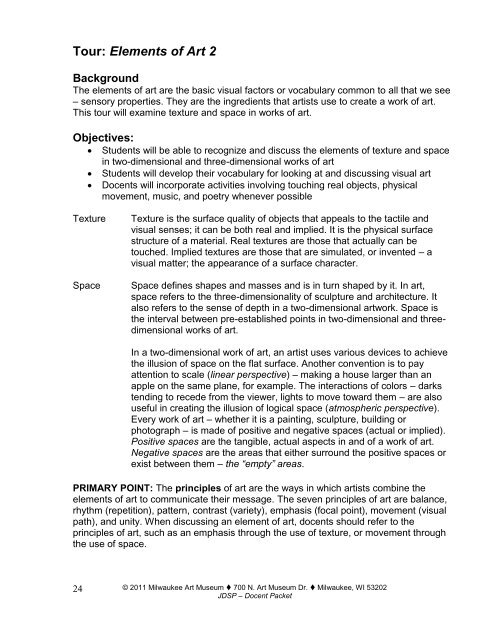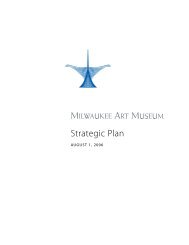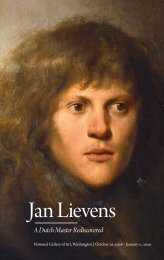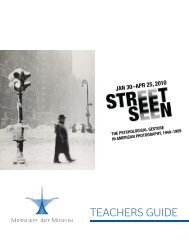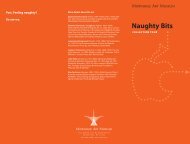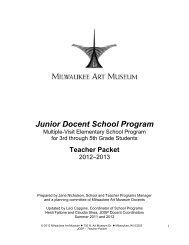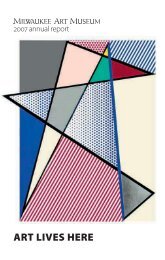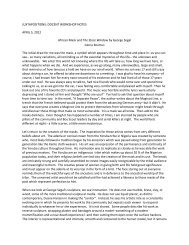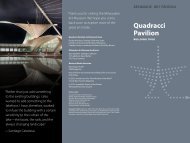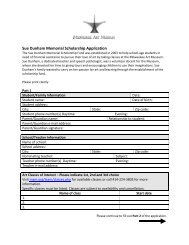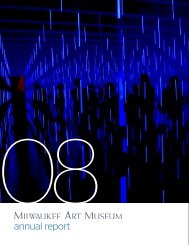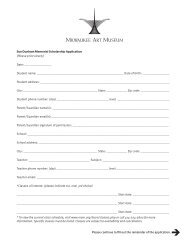Junior Docent School Program - Milwaukee Art Museum
Junior Docent School Program - Milwaukee Art Museum
Junior Docent School Program - Milwaukee Art Museum
You also want an ePaper? Increase the reach of your titles
YUMPU automatically turns print PDFs into web optimized ePapers that Google loves.
Tour: Elements of <strong>Art</strong> 2<br />
Background<br />
The elements of art are the basic visual factors or vocabulary common to all that we see<br />
– sensory properties. They are the ingredients that artists use to create a work of art.<br />
This tour will examine texture and space in works of art.<br />
Objectives:<br />
<br />
<br />
<br />
Students will be able to recognize and discuss the elements of texture and space<br />
in two-dimensional and three-dimensional works of art<br />
Students will develop their vocabulary for looking at and discussing visual art<br />
<strong>Docent</strong>s will incorporate activities involving touching real objects, physical<br />
movement, music, and poetry whenever possible<br />
Texture<br />
Space<br />
Texture is the surface quality of objects that appeals to the tactile and<br />
visual senses; it can be both real and implied. It is the physical surface<br />
structure of a material. Real textures are those that actually can be<br />
touched. Implied textures are those that are simulated, or invented – a<br />
visual matter; the appearance of a surface character.<br />
Space defines shapes and masses and is in turn shaped by it. In art,<br />
space refers to the three-dimensionality of sculpture and architecture. It<br />
also refers to the sense of depth in a two-dimensional artwork. Space is<br />
the interval between pre-established points in two-dimensional and threedimensional<br />
works of art.<br />
In a two-dimensional work of art, an artist uses various devices to achieve<br />
the illusion of space on the flat surface. Another convention is to pay<br />
attention to scale (linear perspective) – making a house larger than an<br />
apple on the same plane, for example. The interactions of colors – darks<br />
tending to recede from the viewer, lights to move toward them – are also<br />
useful in creating the illusion of logical space (atmospheric perspective).<br />
Every work of art – whether it is a painting, sculpture, building or<br />
photograph – is made of positive and negative spaces (actual or implied).<br />
Positive spaces are the tangible, actual aspects in and of a work of art.<br />
Negative spaces are the areas that either surround the positive spaces or<br />
exist between them – the “empty” areas.<br />
PRIMARY POINT: The principles of art are the ways in which artists combine the<br />
elements of art to communicate their message. The seven principles of art are balance,<br />
rhythm (repetition), pattern, contrast (variety), emphasis (focal point), movement (visual<br />
path), and unity. When discussing an element of art, docents should refer to the<br />
principles of art, such as an emphasis through the use of texture, or movement through<br />
the use of space.<br />
24<br />
© 2011 <strong>Milwaukee</strong> <strong>Art</strong> <strong>Museum</strong> 700 N. <strong>Art</strong> <strong>Museum</strong> Dr. <strong>Milwaukee</strong>, WI 53202<br />
JDSP – <strong>Docent</strong> Packet


